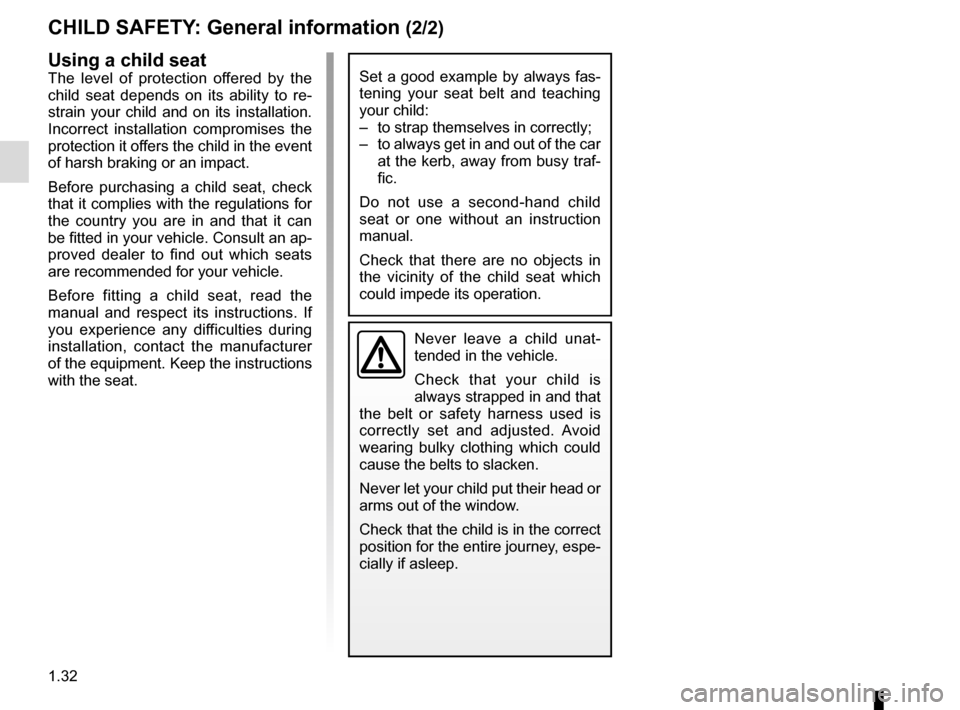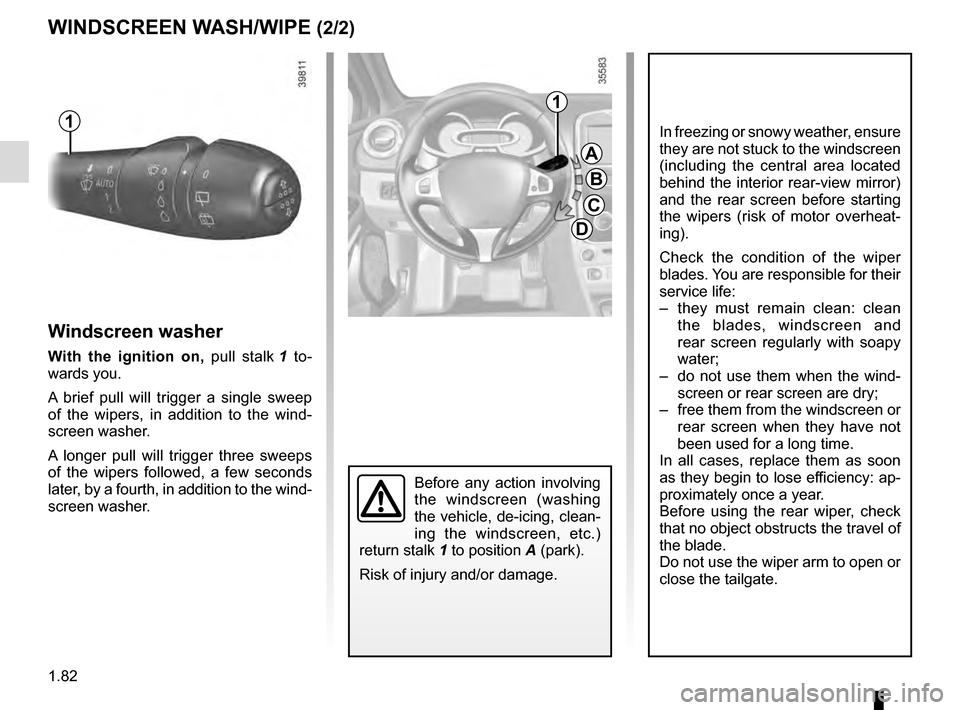Page 38 of 258

1.32
CHILD SAFETY: General information (2/2)
Using a child seat
The level of protection offered by the
child seat depends on its ability to re-
strain your child and on its installation.
Incorrect installation compromises the
protection it offers the child in the event
of harsh braking or an impact.
Before purchasing a child seat, check
that it complies with the regulations for
the country you are in and that it can
be fitted in your vehicle. Consult an ap-
proved dealer to find out which seats
are recommended for your vehicle.
Before fitting a child seat, read the
manual and respect its instructions. If
you experience any difficulties during
installation, contact the manufacturer
of the equipment. Keep the instructions
with the seat.Set a good example by always fas-
tening your seat belt and teaching
your child:
– to strap themselves in correctly;
– to always get in and out of the car at the kerb, away from busy traf-
fic.
Do not use a second-hand child
seat or one without an instruction
manual.
Check that there are no objects in
the vicinity of the child seat which
could impede its operation.
Never leave a child unat-
tended in the vehicle.
Check that your child is
always strapped in and that
the belt or safety harness used is
correctly set and adjusted. Avoid
wearing bulky clothing which could
cause the belts to slacken.
Never let your child put their head or
arms out of the window.
Check that the child is in the correct
position for the entire journey, espe-
cially if asleep.
Page 44 of 258
1.38
CHILD SEATS: attachment by seat belt (1/5)
(1) RISK OF DEATH OR SERIOUS INJURY: Before installing a child seat on the front passenger seat, check that \
the airbag has been deactivated (please refer to “Child safety: fron\
t passenger airbag deactivation and activation” in
Section 1).
Five door and estate versions
Type of child seat Weight of the child Front passenger
seat (1) (2) Rear side seats (6) Rear centre seat
Carrycot fitted
across the vehicle
Group 0 < 10 kg X U (3) X
Rear-facing shell
seat
Groups 0 or 0 + < 10 kg and < 13 kg U U (4) U (4)
Shell seat/rear-facing
seat
Groups 0+ and 1 < 13 kg and 9 to 18 kg U U (4) U (4)
Forward-facing seat
Group 1 9 to 18 kg X U (5) U (5)
Booster seat
Groups 2 and 3 15 to 25 kg and 22 to
36 kg
X U (5) U (5)
The table below summarises the information already shown in the diagram \
on the following pages, to ensure the appli-
cable regulations are respected.
Page 48 of 258

1.42
Utility version
Type of child seat Weight of the child Front passenger
seat (1) (2)
Rear-facing shell
seat
Groups 0 or 0 + < 10 kg and < 13 kg U
Shell seat/rear-facing
seat
Groups 0+ and 1 < 13 kg and 9 to 18 kg U
Forward-facing seat
Group 1 9 to 18 kg U
Booster seat
Groups 2 and 3 15 to 25 kg and 22 to 36 kg U
(1) RISK OF DEATH OR SERIOUS INJURY:
Before installing a child
seat on the front passenger seat, check that the airbag has been deacti-\
vated (please refer to “Child safety: front passenger airbag deactiv\
ation
and activation” in Section 1).
The table below summarises the information already shown on the diagram \
on
the previous page, to ensure the regulations in force are respected. U
= Seat which allows a child seat with
“Universal” approval to be installed
using a seat belt; check that it can
be fitted.
(2) Raise the seat to the maximum and
position it as far back as possible,
tilting the seatback slightly (approxi-
mately 25°).
CHILD SEATS: attachment by seat belt (5/5)
Page 50 of 258
1.44
Five door and estate versions
Type of child seat Weight of
the child Seat size ISOFIX Front passenger
seat Rear side seats (4) Rear centre seat
Carrycot fitted
across the vehicle
Group 0 < 10 kg F, G X IL (1) X
Rear-facing shell
seat
Groups 0 or 0 + < 10 kg and
< 13 kg
E X IL (2) X
Shell seat/rear-facing
seat
Groups 0+ and 1 < 13 kg and 9 to
18 kg
C, D X IL (2) X
Forward-facing seat
Group 1 9 to 18 kg A, B, B1 X IUF - IL (3) X
Booster seat
Groups 2 and 3 15 to 25 kg and
22 to 36 kg
XXX
CHILD SEATS: attachment using the ISOFIX system (2/5)
The table below summarises the information already shown in the diagram \
on the following pages, to ensure the appli-
cable regulations are respected.
Page 53 of 258
1.47
Utility version
Type of child seat Weight of the child Seat size ISOFIX Front passenger seat
Rear-facing shell seat
Groups 0 or 0 + < 10 kg and < 13 kg
EX
Shell seat/rear-facing seat
Groups 0+ and 1 < 13 kg and 9 to 18 kg
C, DX
Forward-facing seat
Group 1 9 to 18 kg
A, B, B1X
Booster seat
Groups 2 and 3 15 to 25 kg and 22 to 36 kg
X
X = Seat not suitable for fitting child seats ISOFIX.
The table below summarises the information already shown on the diagram \
on the previous page, to ensure the regula-
tions in force are respected.
CHILD SEATS: attachment using the ISOFIX system (5/5)
Page 64 of 258

1.58
xAnti-lock braking warning
light
This lights up when the ignition is
switched on and goes out after a few
seconds.
If it lights up when you are driving, it in-
dicates a fault in the anti-lock braking
system.
Braking will then be as normal, without
the ABS. Contact an approved Dealer
as soon as possible.
ÔCoolant temperature warn-
ing light
This comes on when the ignition is
switched on.
If it turns red, stop and let the engine
idle for a minute or two.
The temperature should lower and the
warning light should return to a blue
colour. If not, stop the engine. Let the
engine cool down before checking the
coolant.
Contact an approved Dealer.
WARNING LIGHTS (3/5)
�Electronic Stability Program
(ESP) and traction control
system warning light
This lights up when the ignition is
switched on and goes out after a few
seconds.
There are several reasons for the war-
ning light to come on: please refer to
the information on “Driver correction
devices and aids” in Section 2.
ÄToxic Fume Filter System
Warning Light
For vehicles equipped with this option,
the light comes on when the ignition is
switched on then goes out.
– If it lights up continuously, consult your approved dealer as soon as
possible;
– if it flashes, reduce the engine speed until the light stops flashing. Contact
your approved Dealer as soon as
possible.
Refer to the information on “Advice:
antipollution, fuel economy and driving”
in Section 2.
A
The display of information shown below DEPENDS ON THE VEHICLE EQUIPMENT \
AND COUNTRY.
Page 84 of 258

1.78
EXTERIOR LIGHTING AND SIGNALS (3/3)
fRear fog light
Turn centre ring 4 on the stalk
until the symbol faces mark 5, then re-
lease it.
Operation of the fog lights depends on
the exterior lighting selected, and an in-
dicator light will light up on the instru-
ment panel.
To avoid inconveniencing other road
users, remember to switch off the rear
fog light when it is no longer needed.
Switching off the lights
Turn ring 4 again until mark 5 is oppo-
site the symbol for the fog light you wish
to switch off. The corresponding indi-
cator light goes out on the instrument
panel.
The front and rear fog lights switch off
when the exterior lights are switched
off.
gFront fog lights
Turn centre ring 4 on the
stalk 1 until the symbol faces mark 5,
then release it.
Operation of the fog lights depends on
the exterior lighting position selected,
and an indicator light will light up on the
instrument panel.
When driving in fog or snow, or
when transporting objects which are
higher than the roof, the headlights
do not come on automatically.
Switching on the fog lights remains
the responsibility of the driver: the
indicator lights on the instrument
panel inform you whether the fog
lights are lit (indicator light on) or not
(indicator light not on).
4
5
1
Page 88 of 258

1.82
Before any action involving
the windscreen (washing
the vehicle, de-icing, clean-
ing the windscreen, etc.)
return stalk 1 to position A (park).
Risk of injury and/or damage.
Windscreen washer
With the ignition on, pull stalk 1 to-
wards you.
A brief pull will trigger a single sweep
of the wipers, in addition to the wind-
screen washer.
A longer pull will trigger three sweeps
of the wipers followed, a few seconds
later, by a fourth, in addition to the wind-
screen washer.
WINDSCREEN WASH/WIPE (2/2)
A
B
C
D
1
1
In freezing or snowy weather, ensure
they are not stuck to the windscreen
(including the central area located
behind the interior rear-view mirror)
and the rear screen before starting
the wipers (risk of motor overheat-
ing).
Check the condition of the wiper
blades. You are responsible for their
service life:
– they must remain clean: clean the blades, windscreen and
rear screen regularly with soapy
water;
– do not use them when the wind- screen or rear screen are dry;
– free them from the windscreen or rear screen when they have not
been used for a long time.
In all cases, replace them as soon
as they begin to lose efficiency: ap-
proximately once a year.
Before using the rear wiper, check
that no object obstructs the travel of
the blade.
Do not use the wiper arm to open or
close the tailgate.